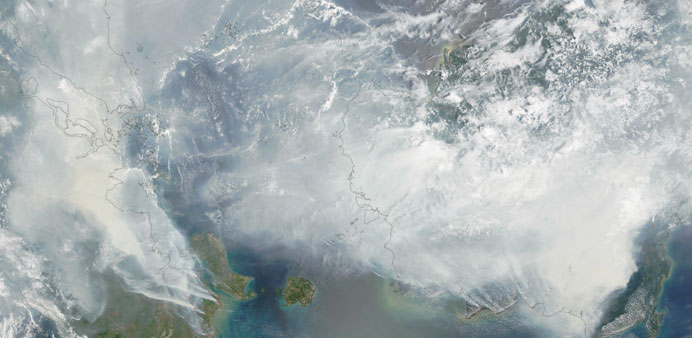This handout image from Nasa and taken from the Moderate Resolution Imaging Spectroradiometer (MODIS) on Nasa’s Terra satellite, shows smoke from fires in Indonesia.
AFP
Jakarta
The forest fires blanketing Southeast Asia are on track to become the worst on record, Nasa has warned, in a crisis that has seen thousands of people seek medical treatment, flights grounded, and schools closed.
Malaysia, Singapore and large expanses of Indonesia have suffered for weeks from acrid smoke billowing from fires on Indonesian plantations and peatlands that are being illegally cleared by burning.
Though the crisis grips the region nearly every year during the dry season, scientists predict the current outbreak could surpass 1997 levels, when out-of-control fires sent pollution soaring to record highs in an environmental disaster that cost an estimated $9bn.
Herry Purnomo, a haze expert at the Centre for International Forestry Research, said yesterday that the dry season was not expected to peak in Indonesia’s Sumatra island until next month.
“It’s not over yet,” he said, adding the economic cost of the “horrendous” fires would be as bad as 1997.
If the dry conditions continue, the region could be enveloped in even denser smog.
“Conditions in Singapore and southeastern Sumatra are tracking close to 1997,” Robert Field, a Columbia University scientist based at Nasa’s Goddard Institute for Space Studies, was quoted as saying by the US science agency earlier this week.
“If the forecasts for a longer dry season hold, this suggests 2015 will rank among the most severe events on record.”
Pressure on Indonesia from its neighbours has intensified this year as the fires have raged on.
Singapore officials have reacted with outrage to Indonesian Vice President Jusuf Kalla’s comments that neighbouring countries should be grateful for good air quality most of the year, and that Jakarta need not apologise for the crisis.
To battle the blazes, Indonesia officials have deployed more than 20,000 troops, police and other personnel to fight the fires through waterbombing and chemically-induced rainfall.
An El Nino weather system has made conditions drier than usual in Indonesia, but authorities are hoping much-needed rains will arrive within a month to finally douse the blazes.
It could be too little too late in Malaysia, where farmers have complained of poor yields due to the haze, and in Singapore where the government has launched legal action against companies blamed for farm and plantation fires.
Authorities worry air quality in Singapore, which improved yesterday to the lower end of the “unhealthy” range after heavy rains overnight, could worsen again depending on the wind direction.
In Malaysia, where weeks of fog-like white-gray smoke has forced repeated large-scale school closures out of health concerns, there are fears the prolonged dry season could spark fires, compounding the disaster.
“That will be a double catastrophe,” said Lim Teck Wyn, who organised a protest march to Indonesia’s embassy in Kuala Lumpur over the haze.
The annual haze crisis has persisted as plantations expand to meet rising global demand for products like palm oil, a key ingredient in a vast range of
everyday consumer products.
The fires smoulder beneath the surface of carbon-rich peatlands, feeding off vast quantities of fuel, making them extremely difficult to curb as millions of tonnes of greenhouse gas emissions are
released into the atmosphere.
The Nasa-linked Global Fire Emissions Database has estimated around 600mn tonnes of greenhouse gases have been released as a result of this year’s fires — roughly equivalent to Germany’s entire annual output.



